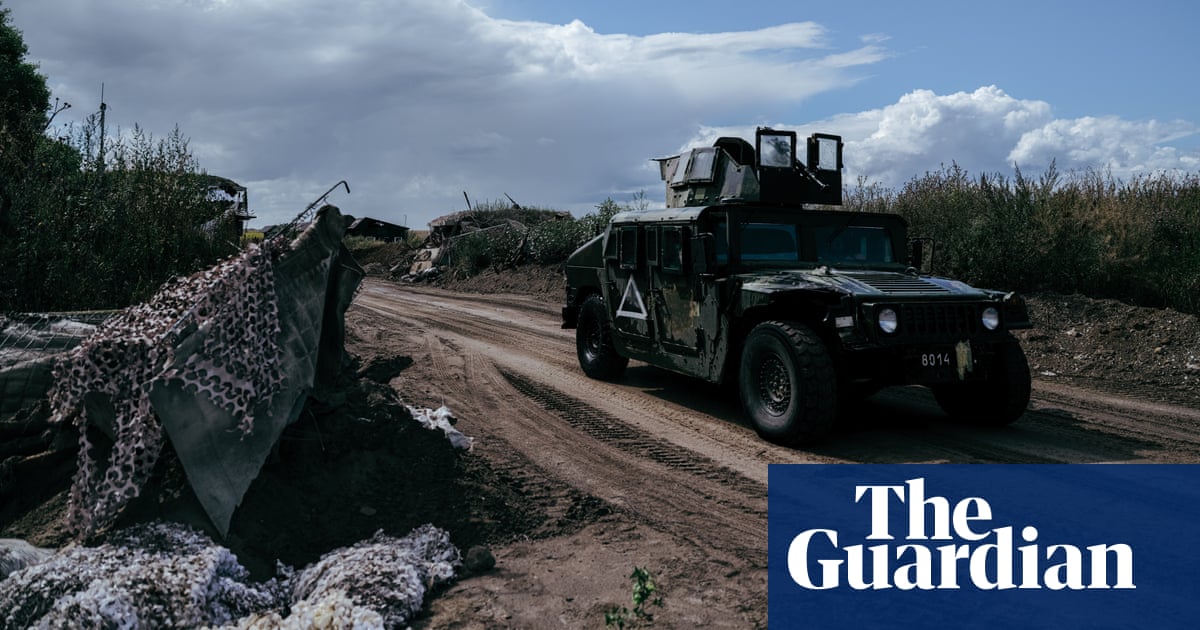The journey from the Ukrainian city of Sumy to the Russian border is deceptively short. In about three quarters of an hour it is possible to arrive at a smashed-up Ukrainian border post and stare over two simple lines of fencing into Russian fields to the right. Except the territory beyond is no longer under Kremlin control.
The Sudzha crossing is now five miles or so from the current frontline inside Russia’s Kursk oblast. For now at least, it remains very much in Ukrainian hands a full week into the border incursion; on a brief visit what could be heard were the pops of outgoing artillery, not the crumps of incoming shells.
Edgy military guards, clips of rifle ammunition tucked into chest pouches, blocked further progress into Russia, a swathe of territory that Ukraine’s foreign ministry said on Tuesday it had no interest in permanently occupying. Instead, it said the attack was justified “to protect the lives of our people” – part of a creative attempt at self-defence, striking where the Russians are weakest.
The crossing fell on the first day of Ukraine’s incursion, and videos released by Ukrainian sources showed a few dozen Russian border guards surrendering, overwhelmed by a surprise, mobile attack. But though severely damaged on the Ukrainian side, most of the destruction was caused earlier in the war: the most notable evidence of the incursion was old debris swept aside to clear the road.
Eight days on, in an area of few roads and remote uncultivated fields, Ukrainian military vehicles, all marked with distinctive white painted or taped triangles are still on the move. Ukrainian sources say Kyiv has committed thousands of the troops to the raid, but what is also notable is the number of armoured vehicles in the region, many more than at other points in the two-and-a-half-year-long war.
Though Ukrainian civilians from the villages north of Sumy reported intense Russian glide bombing and shelling in the immediate aftermath of the start of the incursion on the morning of 6 August, the advance has been such that there are tentative signs that some Ukrainian areas are no longer being hit because Russian guns have been pushed back.
But elsewhere north and north-west of Sumy, where the frontline remains the border, a sense of foreboding remains as military activity has surged. When two aid workers from Global Empowerment Mission, led by a former featherweight boxer Oleg Malynovskyi, visited the apparently deserted village of Bilopillya, six miles from the Russian border, to drop off food packages, a group of mostly elderly residents appeared suddenly to grab what they could before heading off without wanting to speak.
Down the road, Mykola Martinenko, 67, said he now sleeps in a basement next to a neighbour – “this is how we live” he said – showing a makeshift bed in a dusty darkened space with compacted soil for a floor. Russian shelling, he said, been getting progressively worse, since the end of April and has been “more frequent” since Ukrainian incursion began. As if to amplify the point, bangs in the distance, probably from the border, could be heard back at the top of the stairs.
Martinenko said he had no intention of leaving, not least because he had, with a grim irony, moved from the pre-war frontline city of Mariupol to what he thought would be a quiet region in Ukraine’s north. “I lived near Azovstal,” he said, referring to the steel factory where Ukrainian soldiers made a last stand before surrendering in May 2022. But others from the village were preparing to leave for good.
At the mayor’s office, Inna, 31, said the situation had become unbearable, describing regular “powerful strong shelling – when it’s close I grab my children and go to the basement”. Clinging closely to her, but remaining silent, were Rostyslav, six, and Snizhana, three. “It has become too loud, I’m scared for the children, they need to live a normal life,” Inna said. Her plan is to evacuate first to Sumy but then to “move on, go further away, it’s too dangerous”.
Inna’s husband is in the military, and while she says she is supportive of the Ukrainian incursion: “it’s good they went in there, but I can’t put up with this suffering any more.”
She will join about 3,800 Ukrainians who, the region’s governor, Volodymyr Artyukh, said, have evacuated from the northern Sumy region in the past week.
The exodus has left Bilopillya as a depopulated grey zone, according to its mayor, Yuri Zarko, who works with his small team in a basement bunker.
Zarko shows the Guardian around bomb sites in the village. The mayor said he once had hopes of developing industry in Bilopillya, including a green hydrogen plant, but this was scuppered by Russia’s full-scale invasion in February 2022. Now, he says, semi-seriously, that the region’s best hope for growth would be “Nato bases on the border. At least young soldiers could help with the population problem.”
